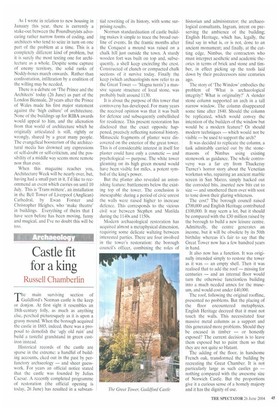Retro modernism
Alan Powers
A.ip-cihitecture is en fête this month, with rchitecture Week (www.architectureweek.org.uk) taking place all over the country, and, for the first time, a more local event. the London Architecture Biennale (www.londonbiennale.org.uk), in Clerkenwell, now the most fashionable London quarter for the profession.
This transformation of architecture into a media and leisure event, even for those who spend the rest of the year working insanely long hours in it, is unprecedented, and these big festivals at last give architecture its place alongside other forms of culture. They go a long way towards correcting the inwardness of architectural culture which is still maintained by the strange language architects are apt to use, and their persistent collective self-belief. The programmes for these events include plenty about older buildings as well as new ones, suggesting the reasonable idea that both should be worth looking at as part of the same process, although it often seems that the public understands this better than the professionals.
Much of the adaptability to people and place that helped architects to climb out of the last recession has survived. The renewed attention to urbanism associated with the same period has been an almost unmitigated good, only marred by the continuing prejudice against suburbs that has delayed more constructive thinking about ameliorating these as well as the newly fashionable inner-cities.
Open-mindedness, like the gloss of urban renewal, may only be skin-deep. The belief that architecture is still part of an ever-advancing movement of modernism never seems to go away for long, and novelty is too often acclaimed for its own sake. One only needed to listen to the brief commentaries on buildings shortlisted for the Royal Institute of British Architects awards, presented at a dinner last week, to realise that novelty is still the trump card. The exterior of Future Systems' new Selfridges in Birmingham, for example, a dark blue blob covered in silver disks, creates an effect that nobody has ever tried to do before, but in every other respect it is more like a piece of retro sci-fi, admittedly a rather enjoyable one, than a novelty. The problem is that nobody feels they can say so or give it a medal for just being a bit silly.
Novelty is all too easily harnessed to raw commercial motives that threaten the long-term regeneration of cities. The reappraisal of the 1960s ought to remind us of the awful consequences of a self-confident architecture out of control. It has always been difficult to follow the middle way in architecture, and most students are trained to disdain 'compromise' but often interpret that as pushing ahead regardless of other factors. If we had a truly mature architectural culture, would one Royal Academician (Sir Nicholas Grimshaw) be willing to make a mess of a listed building by another (H.T. Cadbury-Brown), at the request of a client (The Royal College of Art) that should know better? Would visually damaging alterations to the auditorium of the Royal Festival Hall be proposed by a respected practice (Allies and Morrison), in the face of opposition by a senior architect intimately involved in the job (Trevor Dannatt) and Britain's leading acoustician (Derek Sugden)? As I wrote in relation to new housing in January this year, there is currently a stake-out between the Poundburyists advocating rather narrow forms of coding, and architects who tend to seize in turn on one part of the problem at a time. This is a completely different kind of problem, but it is surely the most testing one for architecture as a whole. Despite some capture of enemy territory, the solid ranks of Noddy-boxes march onwards. Rather than confrontation, infiltration by a coalition of the willing may be needed, There is a debate on 'The Prince and the Architects' today (26 June) as part of the London Biennale, 20 years after the Prince of Wales made his first major statement against the 'high culture' of architecture. None of the buildings up for RIBA awards would appeal to him, and the alienation from that world of architecture which he originally articulated is still, rightly or wrongly, shared by a great many people. The evangelical boosterism of the architectural media has drowned any expressions of self-doubt or self-criticism, and the possibility of a middle way seems more remote now than ever.
When this magazine reaches you, Architecture Week will be nearly over, but, having had a small part in it, I'd like to recommend an event which carries on until 10 July. This is 'Trans mittere', an installation in the Bell Tower of Liverpool (Anglican) Cathedral, by Ewan Forster and Christopher Heighes, who 'make theatre' in buildings. Every-thing of theirs that I have seen before has been moving, funny and magical, and I've no doubt this will be too.



































































 Previous page
Previous page